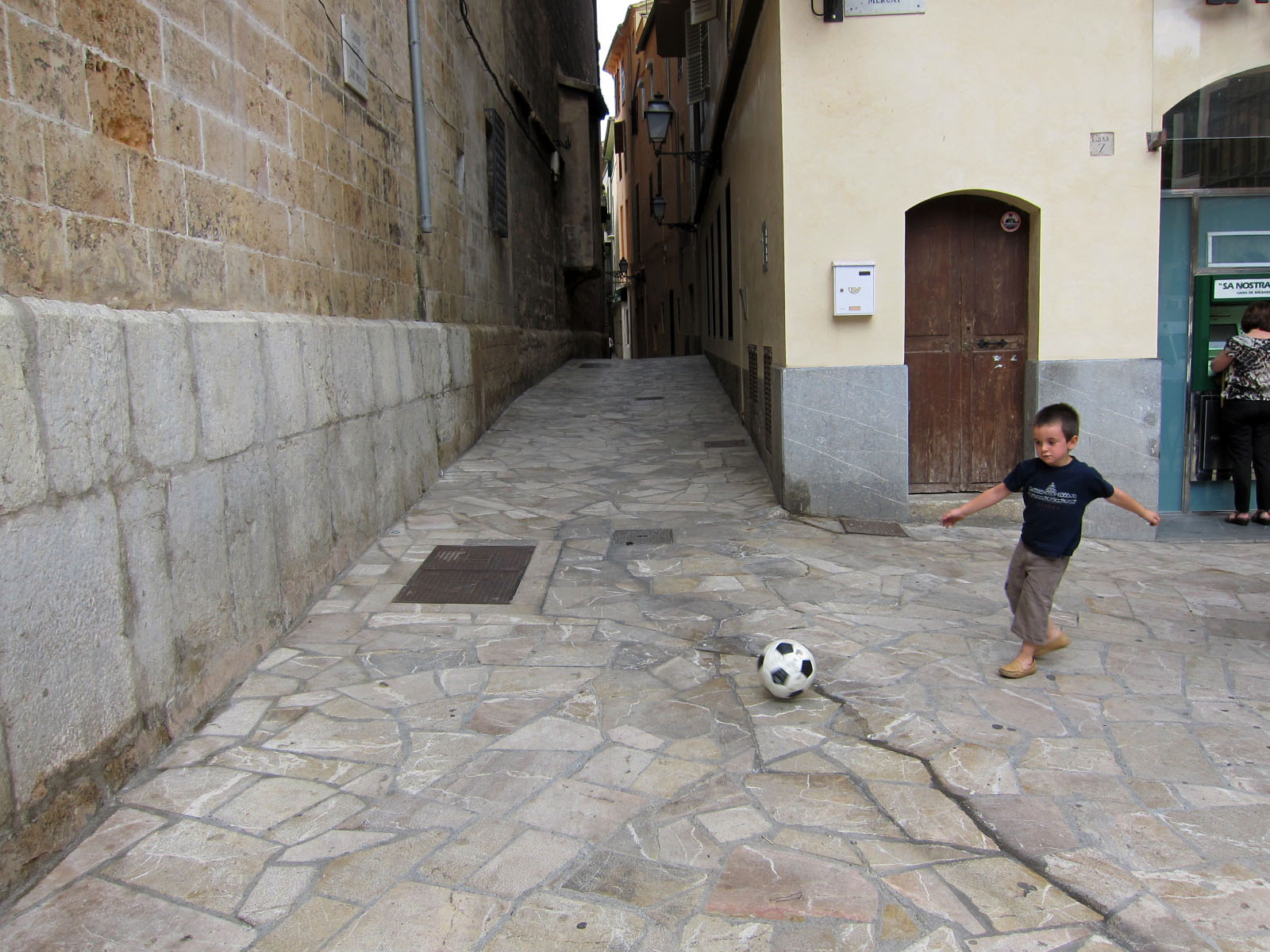 In our many visits to Spain, till now, we’ve never landed in any of the Balearic Islands. Maybe it was the reputation of the Ibiza, the “Gomorrah of the Mediterranean”. We thought the endless electronic dance beat and flashing neon virus invaded all the Balearic Islands. We were wrong.
In our many visits to Spain, till now, we’ve never landed in any of the Balearic Islands. Maybe it was the reputation of the Ibiza, the “Gomorrah of the Mediterranean”. We thought the endless electronic dance beat and flashing neon virus invaded all the Balearic Islands. We were wrong.
Majorca is quite the opposite. Maybe that’s the secret. Everyone stays away because they are afraid of the party.
By saying I might help to ruin a perfect getaway spot, but I’ll do it anyway. Majorca is quiet, charming and wonderful. If there was a disco nightlife, we never saw it. All we saw were lots of quiet cafes, lots of empty streets and lots of small shops.
The Balearic Islands are less than 200 km from Barcelona and the Catalan Coast. Ibiza, the most famous of the islands, attracts the party set with it’s non stop electronic dance music, neon lights and the nude beaches of nearby Formentera.
Menorca is the smallest and most peaceful with a colonial like atmosphere, prehistoric stone monuments, summer festivals and the local favorite, Mahon cheese.
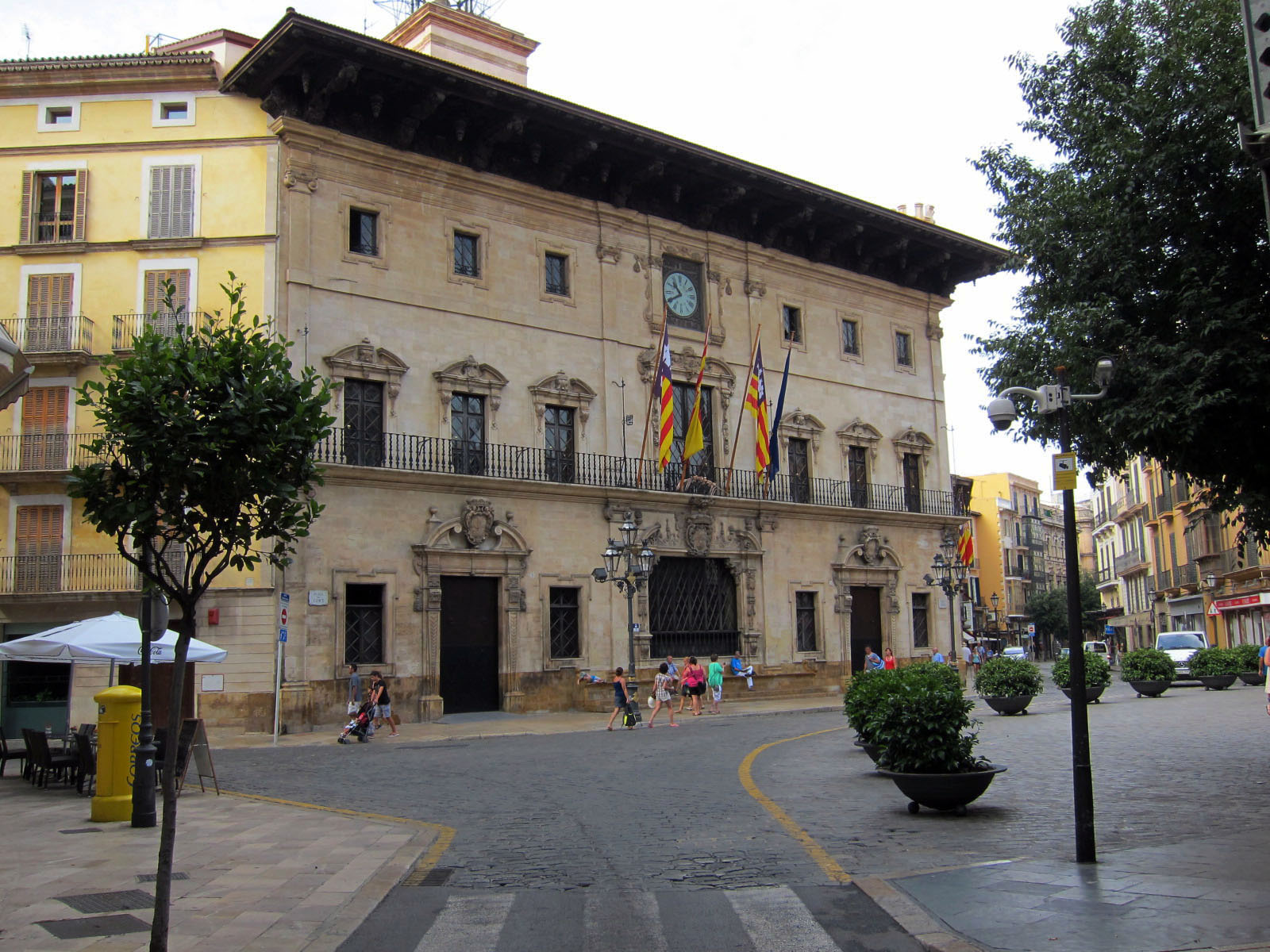 Majorca, is the largest, about 3600 square meters with a population around 1 million. The island is about twice the size of London with 1/10th the population. Palma de Majorca has a population close to 400,000. The rest of the island is pretty quiet, although to be honest, we never left Palma.
Majorca, is the largest, about 3600 square meters with a population around 1 million. The island is about twice the size of London with 1/10th the population. Palma de Majorca has a population close to 400,000. The rest of the island is pretty quiet, although to be honest, we never left Palma.
We passed our four days here walking the old streets, patronizing the cafes and looking into the shop windows. OK, I admit, we did go into quite a few of them.
Majorca has one of those typical Spanish histories, Romans in the 1st century, Vandals in the 5th, Byzantines in the 6th and Moors in the 10th till King James I (Jaume I) routed them out in 1229 and made the island safe for Christians everywhere.
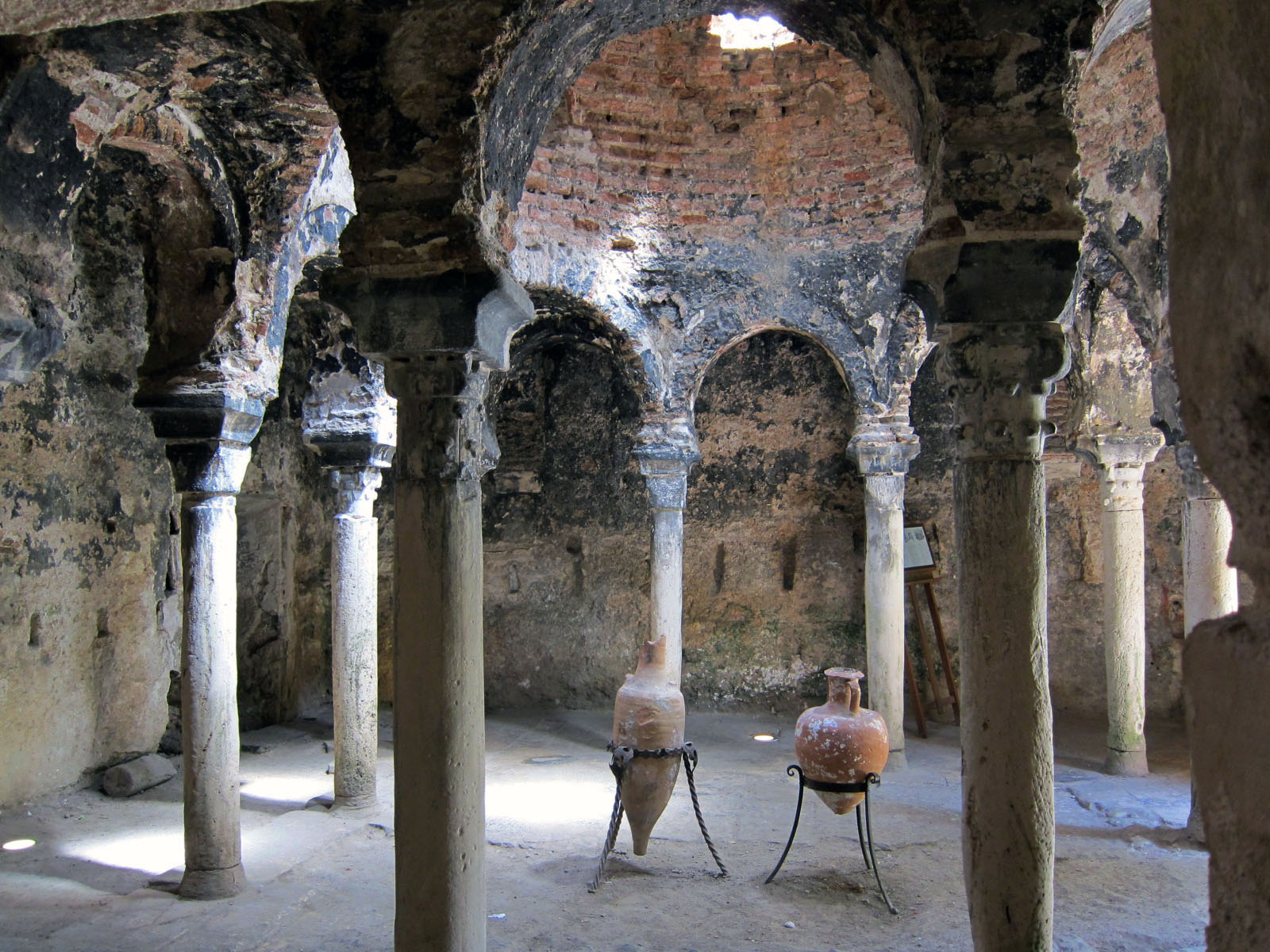 Palma de Majorca is filled with 13th century remains from the time of James I and his son, James II. There are a few old Arab remains (mostly old bath houses). The rest of the Arab/Moorish history is buried below below the Christian city.
Palma de Majorca is filled with 13th century remains from the time of James I and his son, James II. There are a few old Arab remains (mostly old bath houses). The rest of the Arab/Moorish history is buried below below the Christian city.
In the visitor’s guide from the Cathedral (La Seu) there is an explanation that in 902 the Moors settled in Majorca and tolerated the existence of the Christian community. However, when the Moors were defeated in 1229, they were run off the island and their grand Mosque totally destroyed. I guess toleration was a virtue only practiced by the Moors.
King James III (Jaume III) was the last Majorcan King. After being overthrown by his cousin Peter, the island became part of the grander wealth of Aragon, Valencia, Majorca, Sardinian and Corsica. Majorca has been part of something else ever since.
These days, James III is known as the grand tree lined shopping street of Palma, Ave Jaume III.
We’ve booked 4 nights at the Can Cera Hotel in the old town. The building dates back to the Moorish occupation before 1229. It’s been renovated many times over the centuries but still carries a warm 17th century feel with authentic furnishings in all the main rooms. The guestrooms have all been updated to include 21st century comforts. It’s quiet, very comfortable and the staff is great.
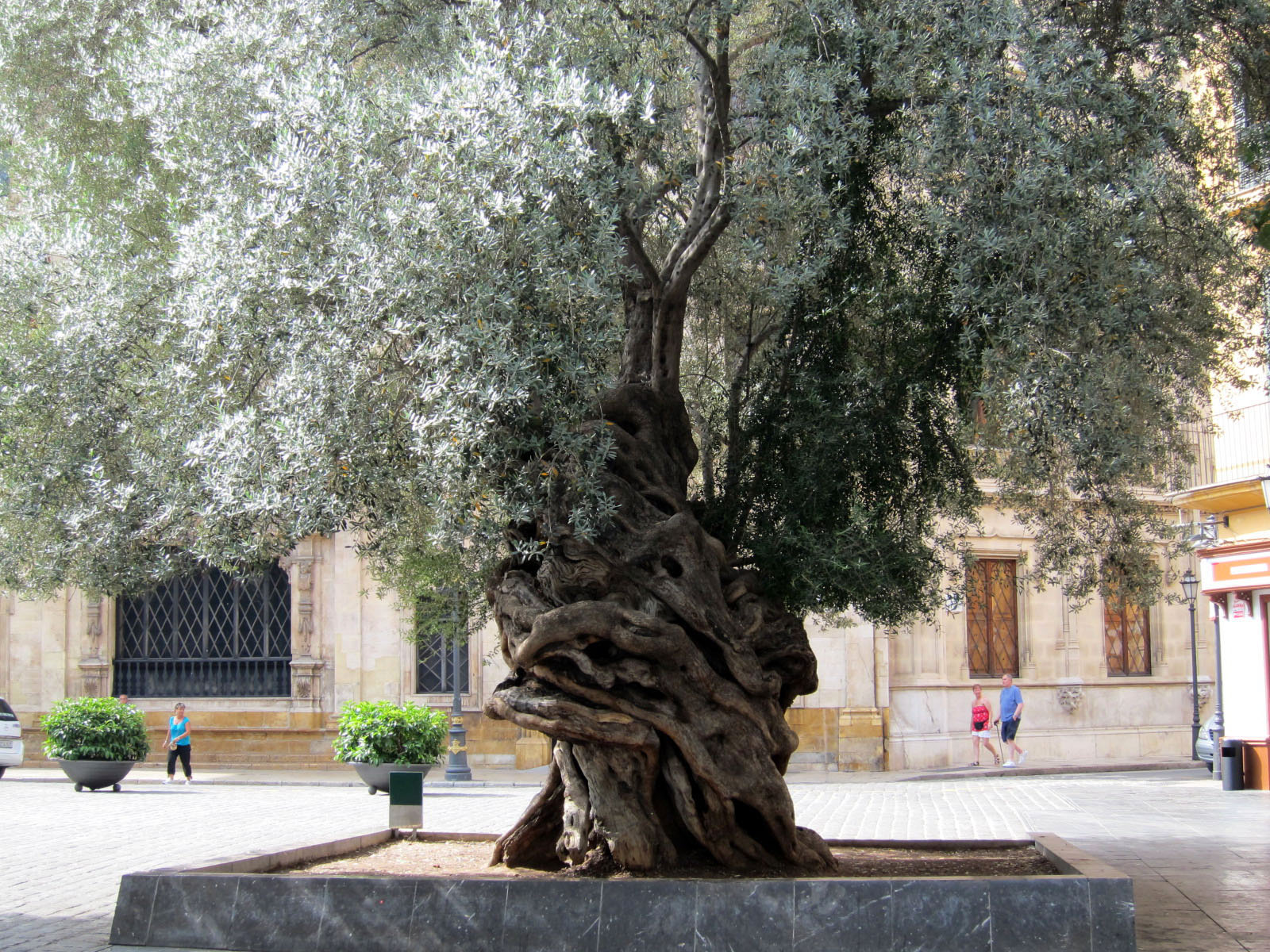 In our four days in Palma, we rarely left the small winding streets of the 13th century old town. Most of these streets are pedestrian only which makes it wonderful for strolling around.
In our four days in Palma, we rarely left the small winding streets of the 13th century old town. Most of these streets are pedestrian only which makes it wonderful for strolling around.
Walking from the hotel to the left, we are a 3 minute walk from the 17th century Ayuntamento (the old town hall), still in operation, which sits across the square from the 1000 year old Olive tree. The main industry of the island is olives and this tree must be the grand-daddy of them all.
Walking from the hotel to the right, we are a 3 minute walk to the 13th century Basilica de San Francisco. Although this is a very famous Majorcan church, what attracted us to it was the statue of Junipero Serra.
We live in northern California where there are dozens of references to Junipero Serra, the Franciscan Monk known as the father of California. In the late 1700’s, he founded missions and settlements from San Diego to north of San Francisco. His name is venerated all over the state.
In the Bay Area, there is a giant statue of him in San Francisco’s Golden Gate Park, a modern concrete statue of him along the stretch of Highway 280 that bears his name. We have the Serramonte Shopping Mall, a couple of Junipero Serra High Schools. In Daly City, we even have a bowling alley named the Serra Bowl.
We never knew he was from Majorca. How strange to see him just around the corner.
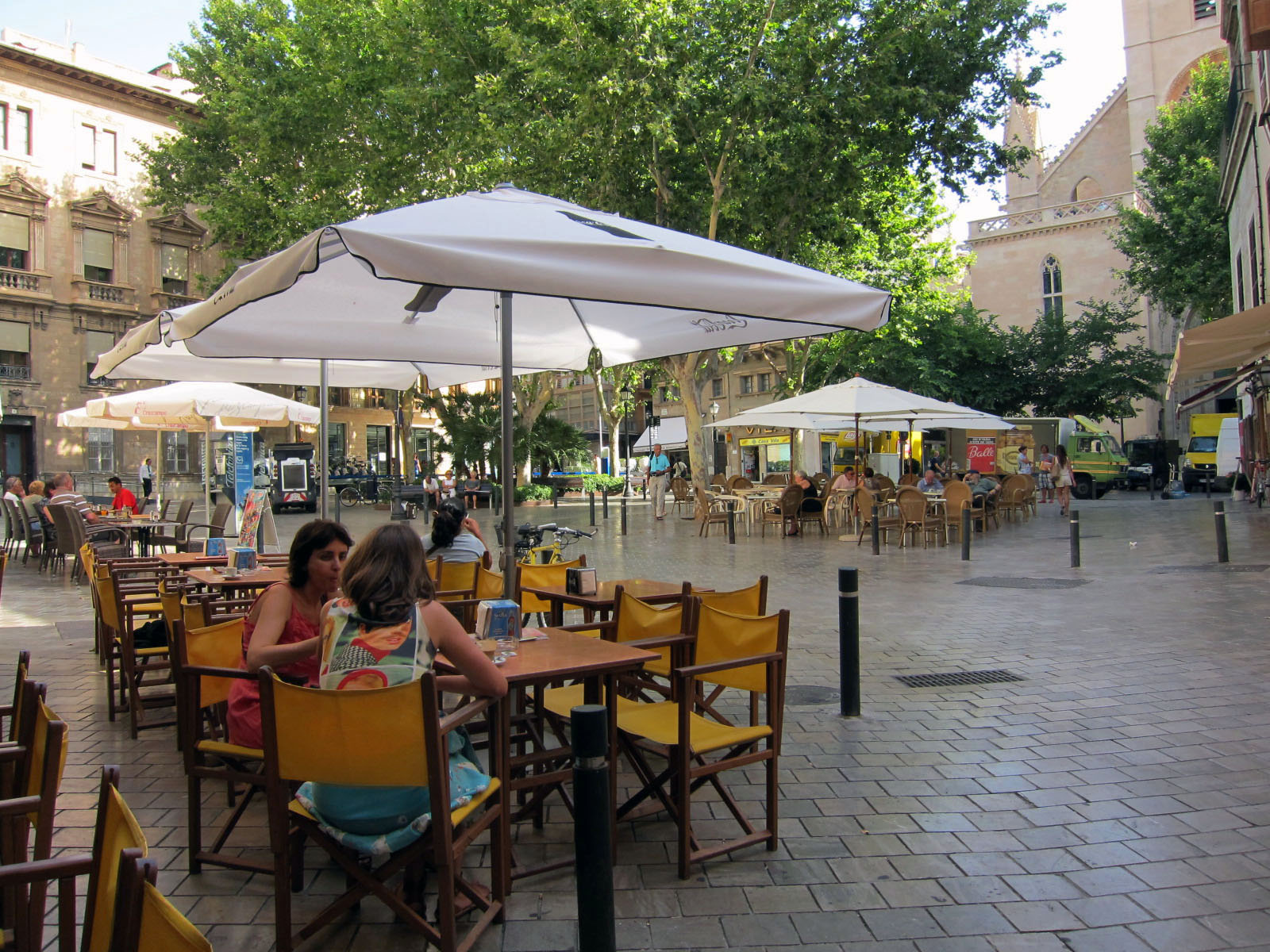 We are also a 2 minute walk from the beautiful Placa Santa Eulalia where we sit each morning for café and tortilla, the traditional spanish potato and egg omelet. We return to the same café every afternoon for cold beer and olives. We could (and did) spend hours there watching the interesting people go by. Our favorite table is the empty one just to the left of the two women in the photo.
We are also a 2 minute walk from the beautiful Placa Santa Eulalia where we sit each morning for café and tortilla, the traditional spanish potato and egg omelet. We return to the same café every afternoon for cold beer and olives. We could (and did) spend hours there watching the interesting people go by. Our favorite table is the empty one just to the left of the two women in the photo.
We spent a lot of time sitting at cafes and watching people. In one café we sat down next to a man dressed like snow white surrounded by a group of his friends all wearing t-shirts with the names of the seven dwarfs in Spanish. He explained to us he was getting married next month and it is a tradition in Majorca for the friends to conceive an embarrassing trick to play on him before the wedding. They decided to be Snow White and the seven dwarfs for the day. Actually, only six dwarves showed up. Tontin (Dopey) was missing. So it goes.
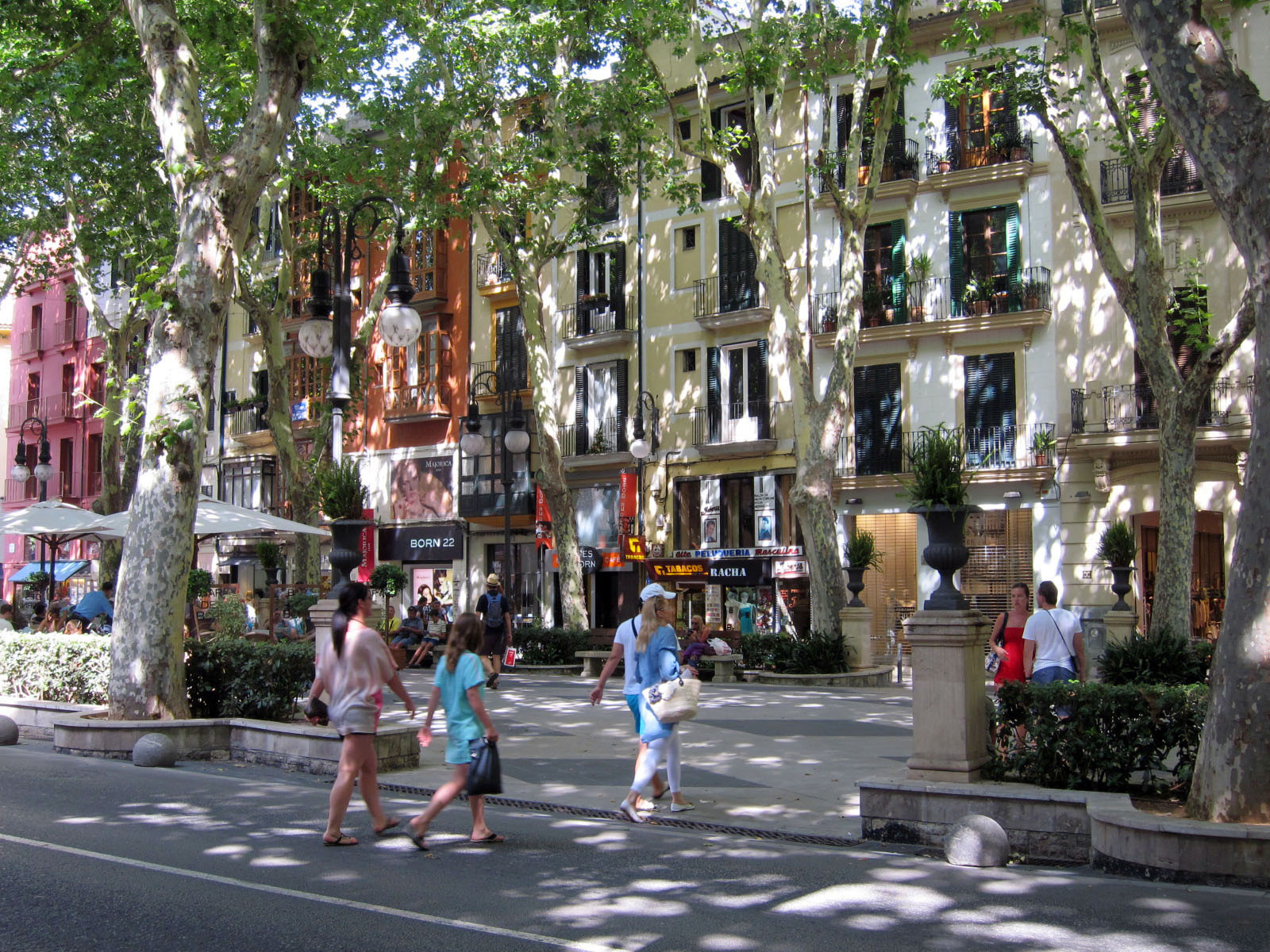 Palma is a café and shopping paradise. The weather is perfect, warm with cool Mediterranean breezes during the day and cool night. Both you and your wallet get very relaxed.
Palma is a café and shopping paradise. The weather is perfect, warm with cool Mediterranean breezes during the day and cool night. Both you and your wallet get very relaxed.
This island is the home of the Majorica pearl industry, imitation pearls made of glass beads covered with layers of pearlescent lacquer. The Majorica company started in 1890 and by 1951 they became a global fashion accessory. They are sold all over Spain (and the world) but most people feel that Palma is the motherlode.
The Majorica pearls are very affordable but the shopkeepers are smart enough to display them next to the more expensive natural, fresh water and cultured pearls. For most people, once they see the difference, they pay a little more and go for the real version. Actually, the organic looking natural fresh water pearls are not much more expensive than the perfectly round majorica pearls.
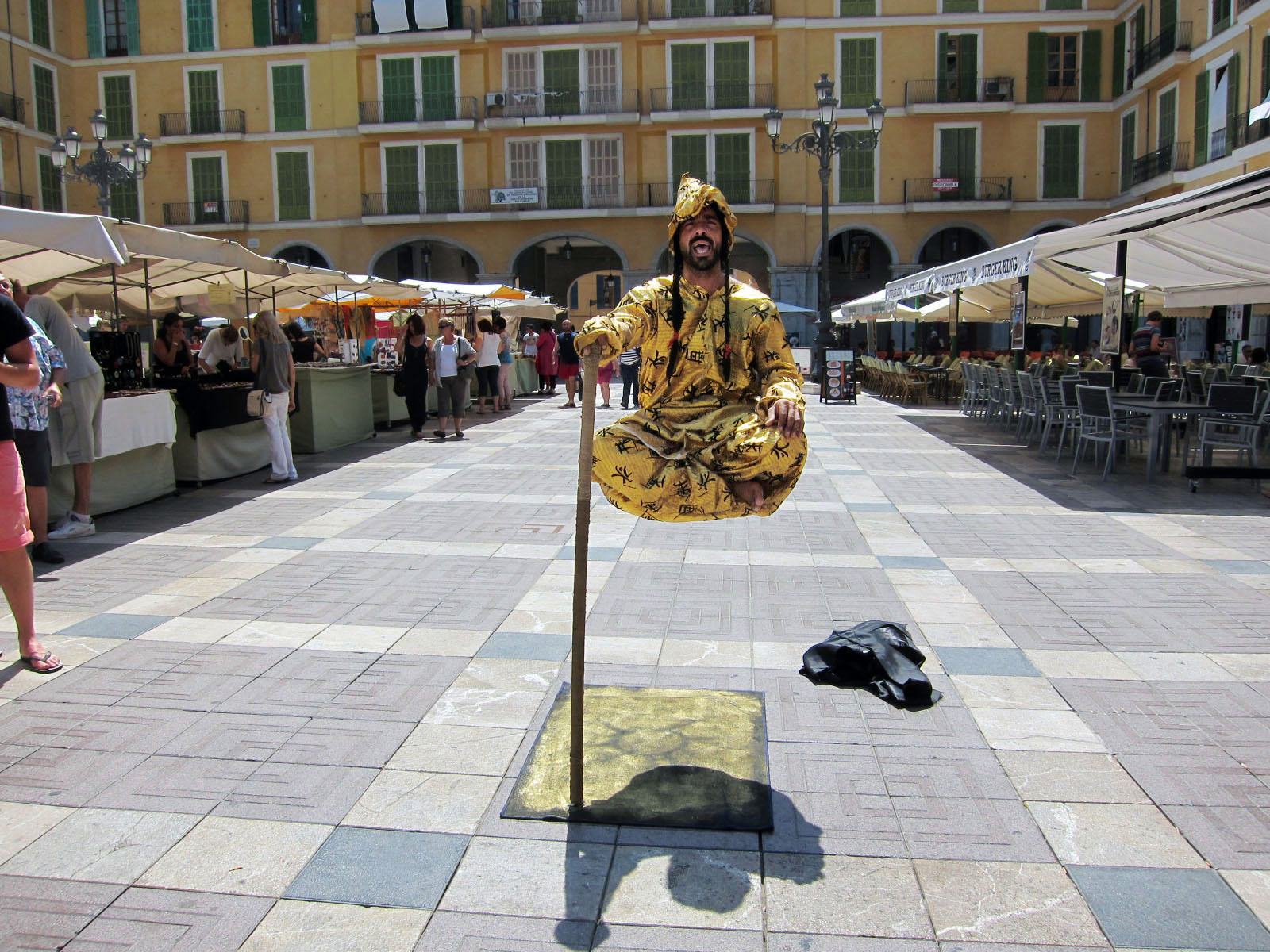 On Saturdays, a crafts fair fills the Placa Major, but we hardly noticed. Most of the attention in the square was going to the street performers.
On Saturdays, a crafts fair fills the Placa Major, but we hardly noticed. Most of the attention in the square was going to the street performers.
Spain has always provided us with the best street theatre, from the classical guitarists of Madrid to the silly statuesque costumes of the Ramblas of Barcelona. Here in Placa Major though we were treated to something we’ve never seen before, an amazing levitation trick.
We understood there was a counterweighted plate under the rug, and there was a harness that extended through his sleeve to support his body but we had no idea how he got into the pose. We waited for at least 30 minutes hoping he would take a break but he never did. I think whenever he did get down, he probably just picked up his euros and went home.
There were other characters around him trying to get the attention and euros of visitors; a woman dressed like SpongeBob SquarePants folding balloons, a man dressed as a monstrous bride, two people fashioned to look like terracotta figures and an obsidian black cowboy to name a few, but they had nothing on the levitating man. He was gathering all the coins and all the people.
As we exited the Placa Major, we passed a small, amplified string band playing island reggae music under the cover of the entrance to the old home of Juan Alberto March Ordinas, a Spanish nationalist during the Spanish Civil War who sided with Franco and did very well for himself. The March Ordinas home is now an art gallery on one side and a branch of the Banaca March on the other.
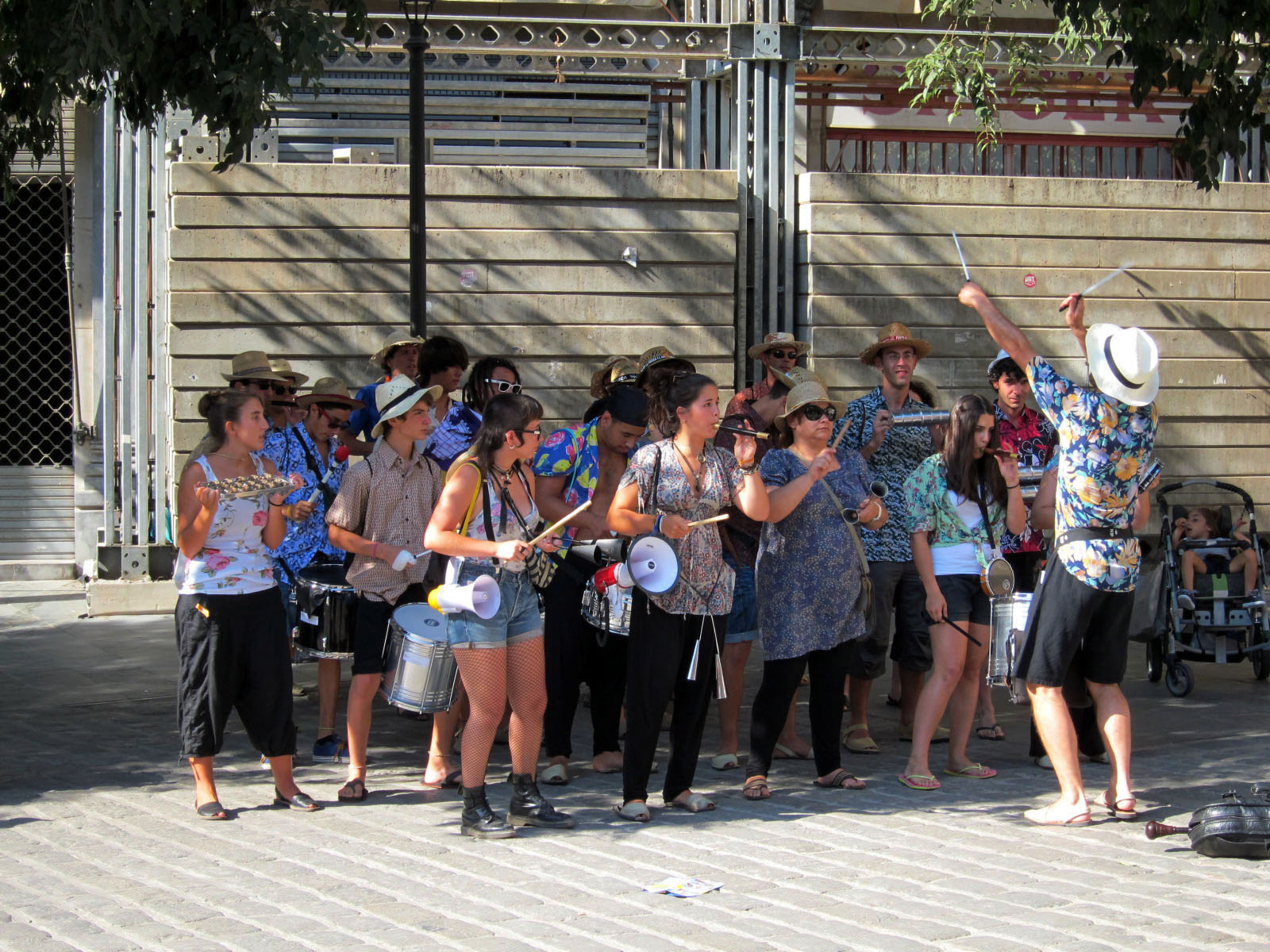 There is really good street music all over the city, classical guitarists playing in the park below the Almudaina Palace, a drum orchestra outside of the Town Hall and contemporary sounds along the Passeig des Born, the tree lined avenue filled with cafes and shops. Just like a film, each neighborhood had a different mood and a different score.
There is really good street music all over the city, classical guitarists playing in the park below the Almudaina Palace, a drum orchestra outside of the Town Hall and contemporary sounds along the Passeig des Born, the tree lined avenue filled with cafes and shops. Just like a film, each neighborhood had a different mood and a different score.
After listening to bad accordian players annoy touists for a month in Rome, this was really refreshing.
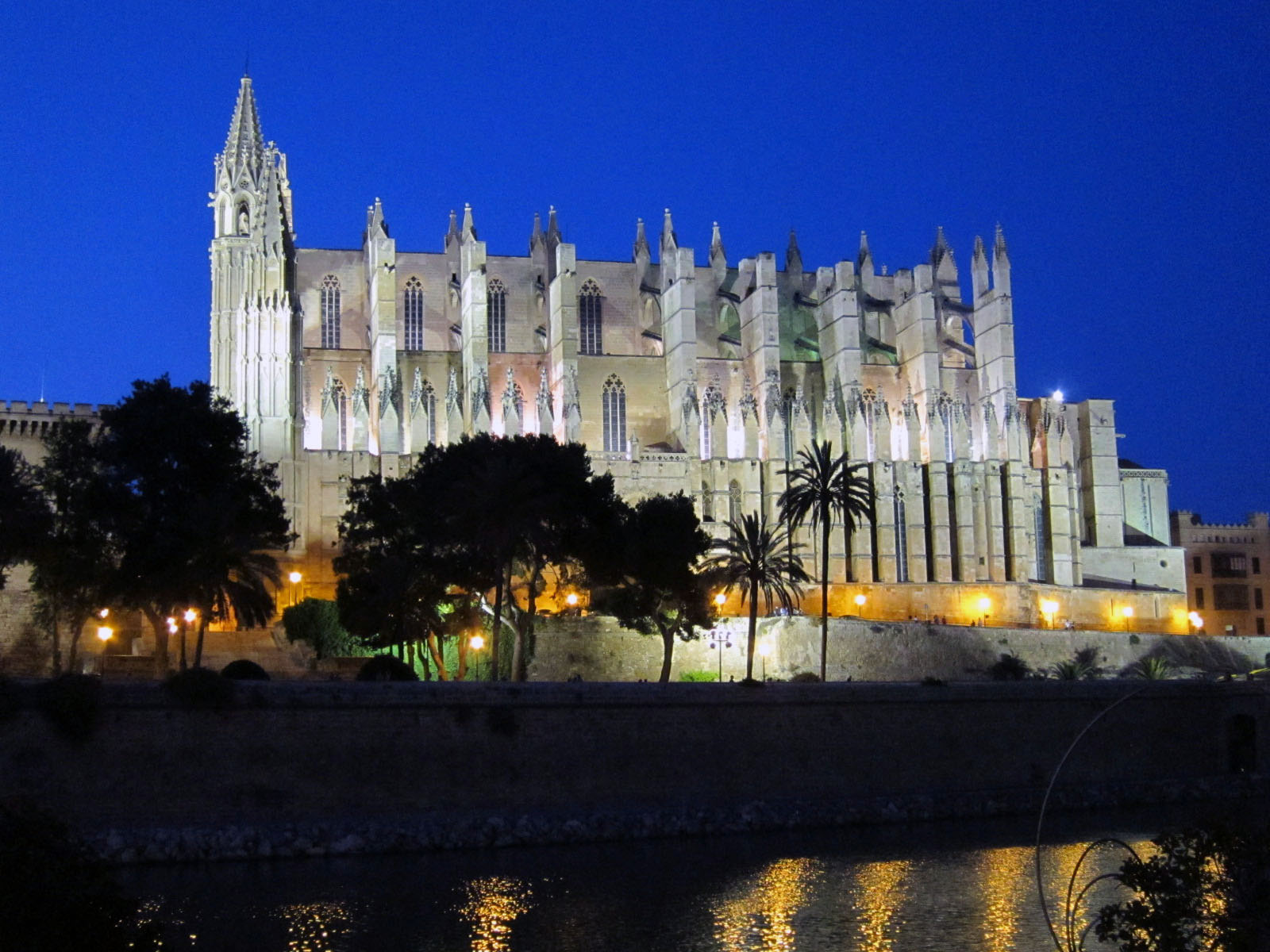 La Seu (the Majorcan sandstone Cathedral of Santa Maria di Palma), also called the Cathedral of Majorca is close to 400’ long and 180 ft wide and a soaring 144 ft tall. It’s tied for the 3rd tallest gothic church in the world. The photo below was taken from pretty far away.
La Seu (the Majorcan sandstone Cathedral of Santa Maria di Palma), also called the Cathedral of Majorca is close to 400’ long and 180 ft wide and a soaring 144 ft tall. It’s tied for the 3rd tallest gothic church in the world. The photo below was taken from pretty far away.
An earthquake in 1851 damaged the upper half of the main façade but it was restored to the original design. In 1901 Antonin Gaudi was brought for some renovations, but he left in 1914 after too many problems with the contractor who brought him in.
The large canopy over the alter is one of the Gaudi designs. He is also responsible for moving the choir closer to the main alter, and along with the architect designer Joseph Jujol, they created ceramic elements for the two strange alter pieces at either side of the main alter. Some things work, some things don’t. Maybe these two alter pieces were the cause of the arguements.
There are a few other Gaudi designs the Church is eager to point out once you’ve paid the entrance fee.
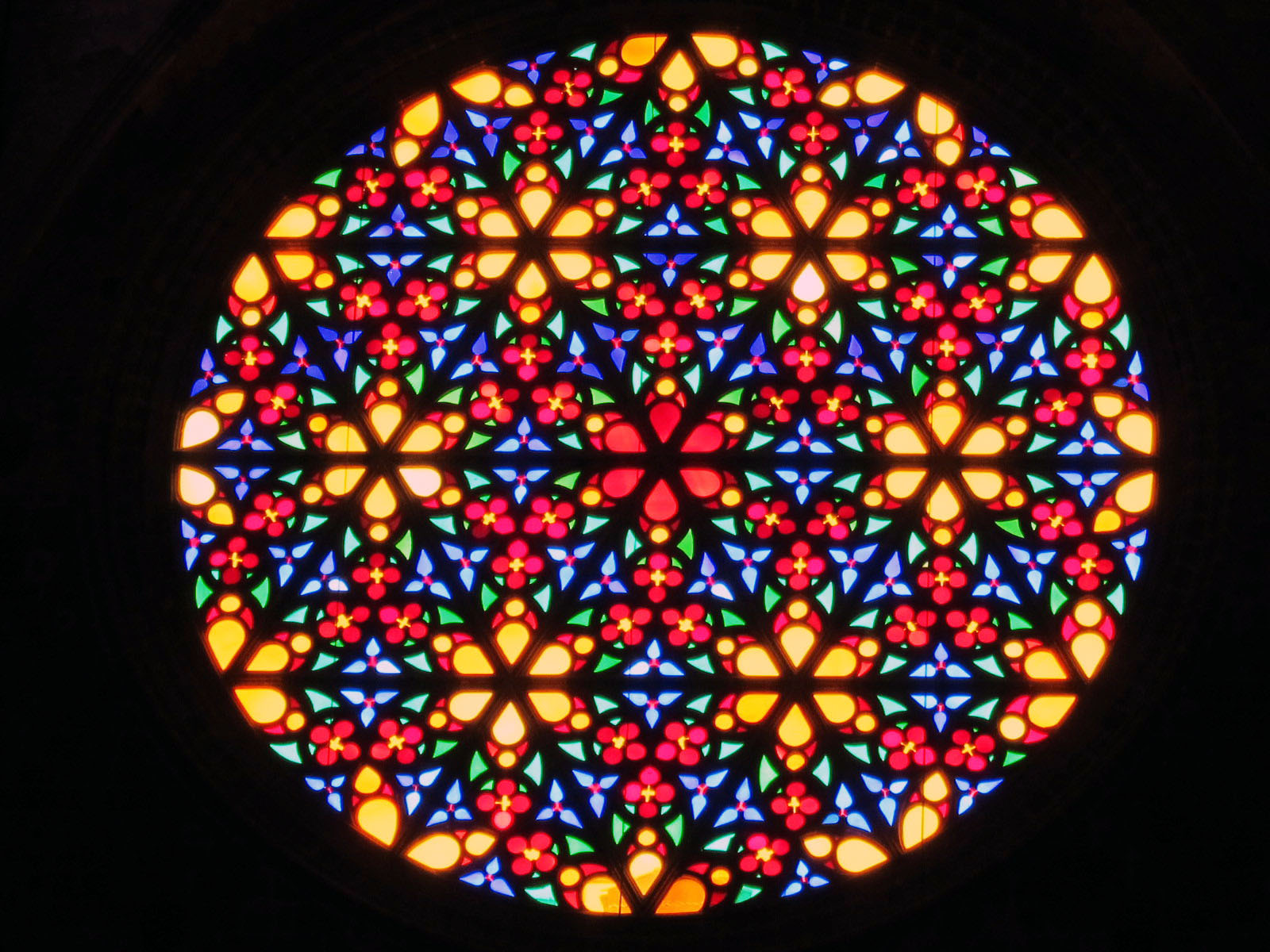 The light in the church is amazing. There are 61 stained glass windows and the position of the church allows a lot of light in at all hours of the day. The large rose window measures over 11meters in diameter. It’s the largest gothic rose window in the world and was on fire when we were there.
The light in the church is amazing. There are 61 stained glass windows and the position of the church allows a lot of light in at all hours of the day. The large rose window measures over 11meters in diameter. It’s the largest gothic rose window in the world and was on fire when we were there.
Next door to the Cathedral is the grand Almudaina Palace, Christianized in 1229 when James I defeated the Moors. When it was the Moor fortress it was known as Almudayna. Many of us Americans grew up in towns named after the Indians the Colonists had wiped out to make the world safe for good Christians everywhere. It seems to be a universal theme.
 The fortress commands a spectacular view of the Bay of Palma. You can literally see for miles out into the Balearic Sea. Before the Almudayna of the Moors, there were the foundations of a Visigoth fortress, and before the Visigoths, it was a Roman fortress. It’s just a good location for a fortress, or a Palace.
The fortress commands a spectacular view of the Bay of Palma. You can literally see for miles out into the Balearic Sea. Before the Almudayna of the Moors, there were the foundations of a Visigoth fortress, and before the Visigoths, it was a Roman fortress. It’s just a good location for a fortress, or a Palace.
We are told by the literature that comes with the price of admission that most of what exists in the Palace is from James II in the 13th and early 14th century, even though most of it was reconstructed in the 1970s.
However, the 10th century Arab baths underneath Almudaina are all original very well preserved.
The Palace (the private wing) still serves as the royal Palace when the King and Queen are in town, and from what we’ve read, Queen Sofia likes to shop on Ave Jaume III.
Almudaina is also the military HQ of the Balearic Islands and of course, a museum.
We tried to visit the Es Baluard, the contemporary art museum that opened in 2004, but they were closed. We saw the esterior and the bookstore.
Joan Miro moved to Palma in the 1950’s and lived here till he died in 1983. The Fundacio Pilar I Joan Miro is a great collection of his work. Unfortunately, the day we wanted to visit they were closed.
The 14th century circular Bellver Castel, also closed.
We usually plan ahead to see when the museums are closed. This time we didn’t. Oh well, something to come back for.
We did manage to see an interesting exhibit of George Grosz drawings in the Fundacio La Caixa. This was once the 1903 Grand Hotel of Majorca, designed by Luis Domenech I Montaner, one of the father’s of the Modernista (art nouveau) movement in Spain, who designed the Palau de la Musica Catalana in Barcelona. The Palau del la Musica might be his most famous, but this building (The Grand Hotel) was his first.
We thought we would see everything in the city in less than three days. We had plans to take the old 1912 wooden train through the mountains to Soller and spend another day at one of the beautiful beaches a couple of kilometers out of town, but after three days enjoying the slow life of the quiet streets and quiet cafes, by the fourth day we realized we missed a lot. We also realized we will be coming back.
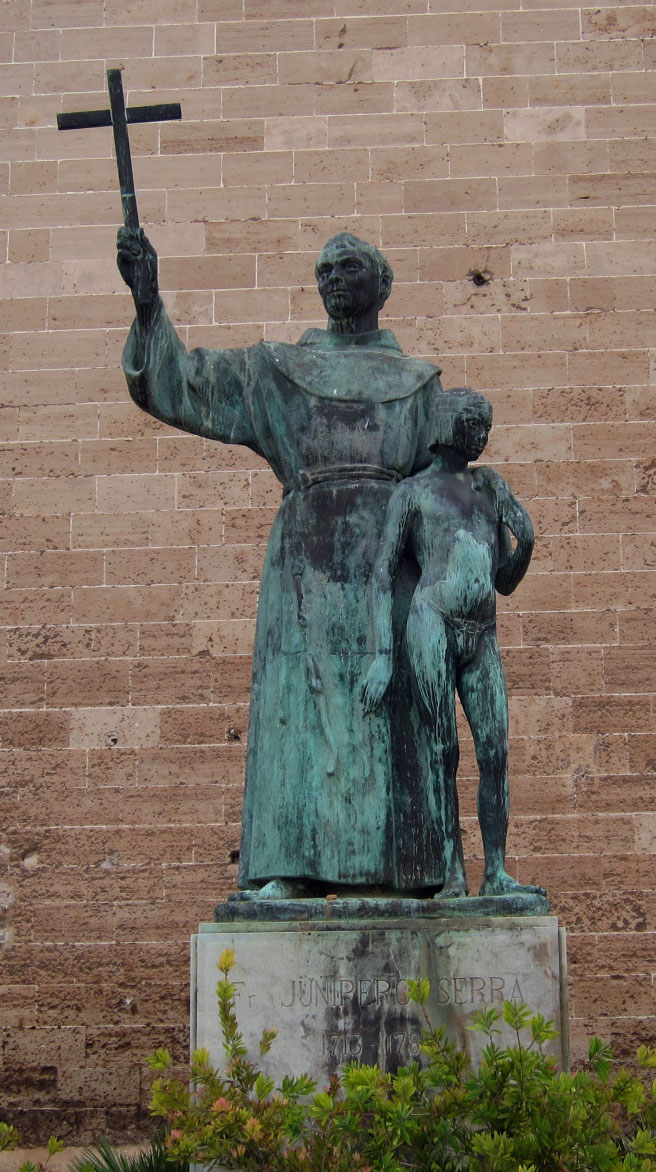
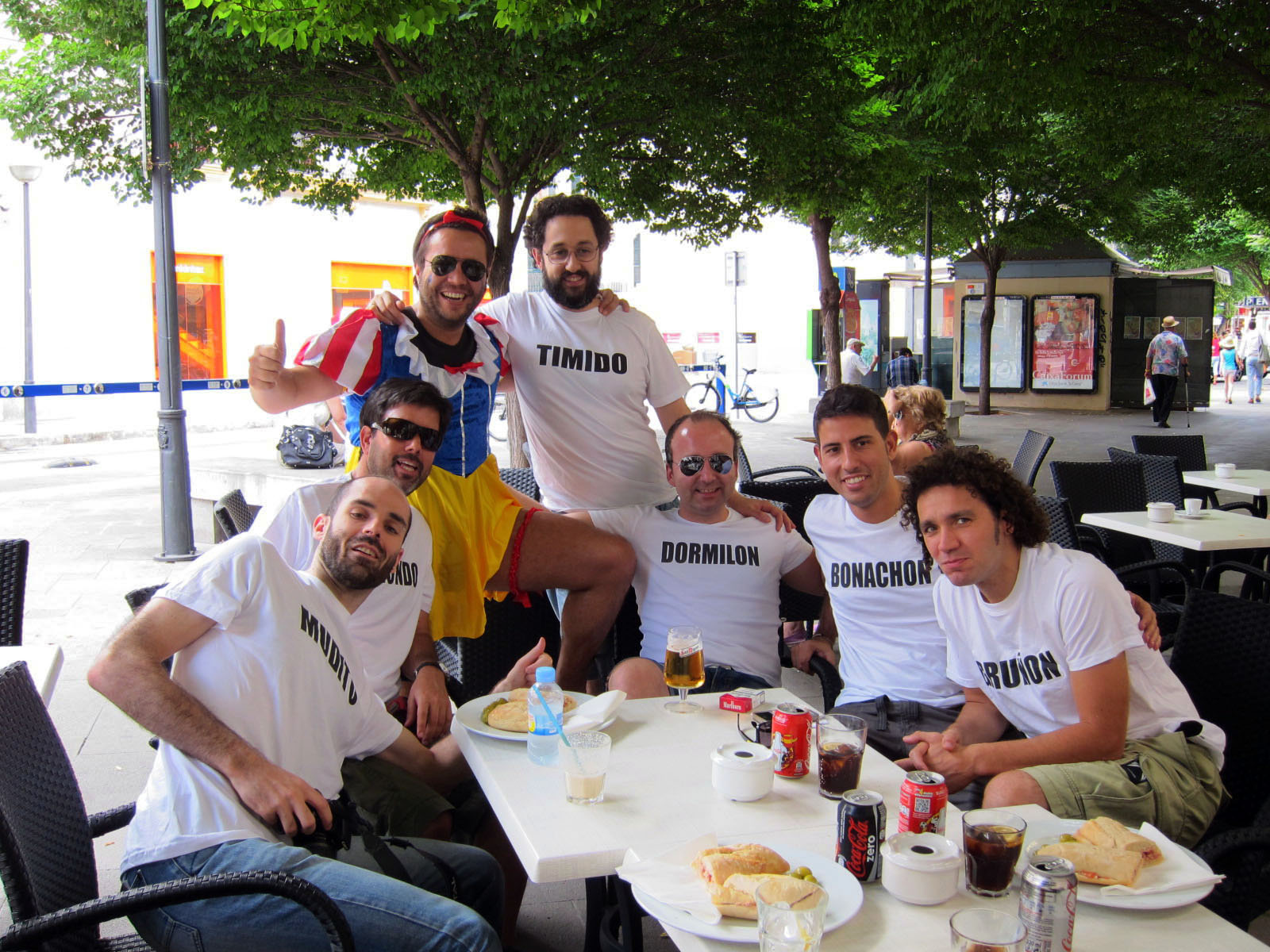
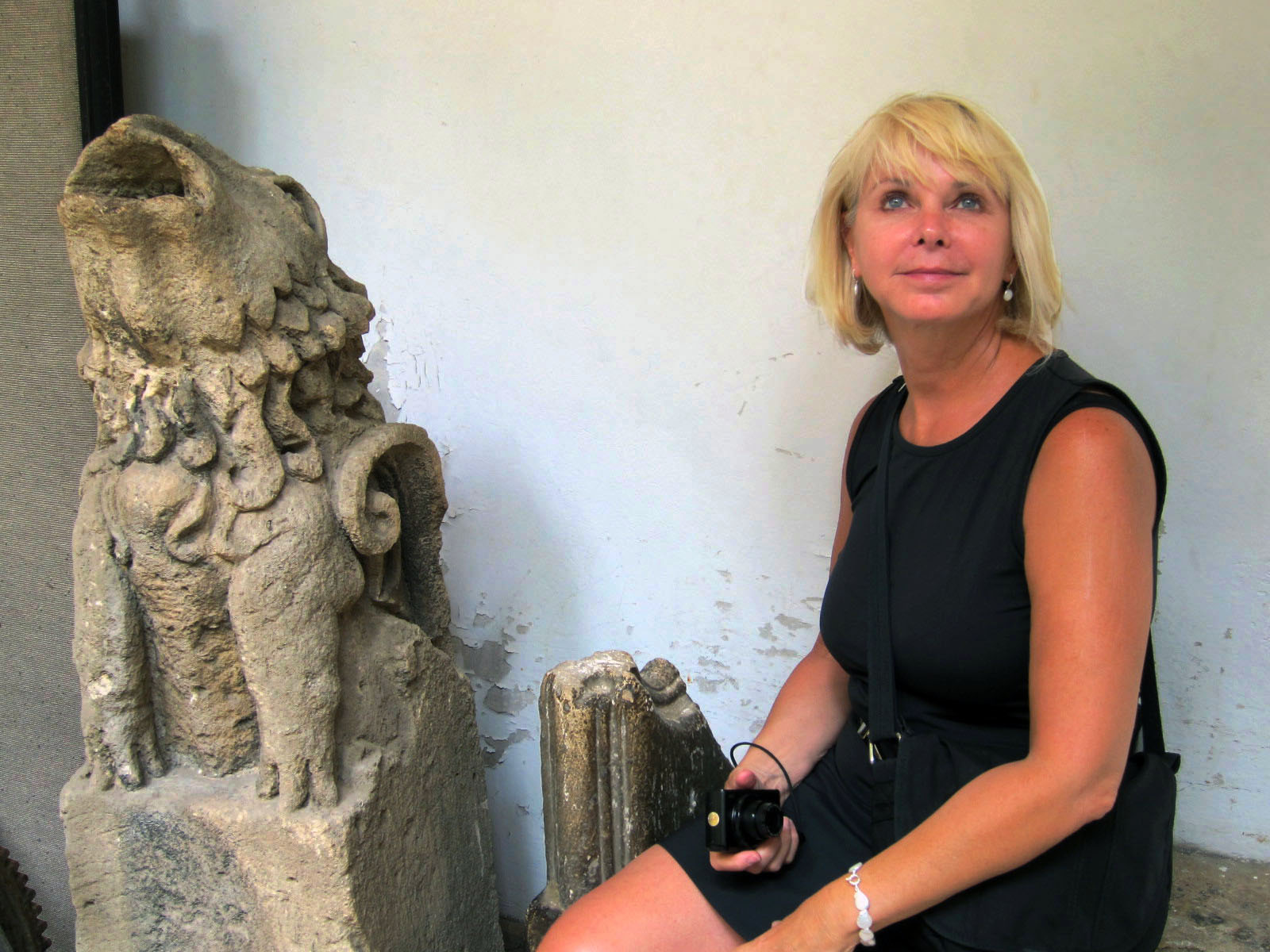
You must be logged in to post a comment.